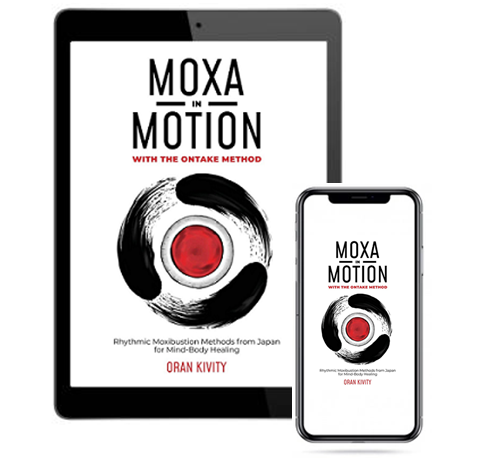We use cookies to make your experience better. To comply with the new e-Privacy directive, we need to ask for your consent to set the cookies. Learn more.
Moxa in Motion with the Ontake method - eBook format
Moxibustion is ancient. Even more ancient that needling. In modern acupuncture, however, it is often considered too time consuming or difficult to master. And yet the classics say: for chronic conditions, moxa has no equal.
Coming to the rescue of time-poor, present-day acupuncturists is the Ontake Method from Japan. This innovative technique uses a piece of bamboo filled with burning moxa wool to roll, tap and press on the acupuncture meridians using a metronome programmed to each meridian's frequency. The rhythmic application of heat, frequency and pressure triggers rapid shifts in your patients' body condition and mood.
Oran Kivity is a veteran acupuncturist from the UK. The founder of Sayoshi.com, the online directory of Japanese acupuncture, he has dedicated countless hours of clinical observation and study to integrate the knowledge of contemporary Japanese masters. Through writing and teaching he has ignited interest in Ontake, a remarkable new moxa tool from Japan, developing these dynamic new techniques further and compiling them into this practical handbook of moxibustion.
In this book, you will learn:
- Dr Manaka's meridian frequencies and how to apply them
- Branch treatments for symptom relief
- Root treatments for whole-body regulation
- The integration of Dr Tan's holographic models with Ontake for the rapid relief of pain in the neck, back and joints
Moxa in Motion presents a step-by-step guide to clinical practice utilising the Ontake Method. Easily integrated into any style of acupuncture, Shiatsu or Tuina, the Ontake Method will boost your results and build your practice.
*The price of this eBook is based on the current exchange rates from £11.99. This could alter slightly depending on the live rates*
The ontake or warm bamboo - a piece of bamboo full of burning moxa - is a new method of moxibustion that is growing in popularity. In the title of this book, Oran Kivity emphasises that ontake represents a dynamic change to the relatively static classical approaches to moxibustion. In the book he shows the reader how to use ontake to increase clinical efficiency and flexibility.
The book is organised into four parts: the Basics, Root and Branch, Going Holographic and Bamboo Shoots. In the first chapters the author introduces the origin and characteristics of this method of moxibustion, and shows the reader step by step how to perform it. Throughout the text the author's experience in the field of acupuncture is obvious, especially in the Japanese tradition. Acupuncturists will gain great benefit from his clear and practical explanations of theory, influenced by Yoshio Manaka, Stephen Birch and the Toyohari approach to acupuncture. Indeed, an important aspect of this book is Manaka's method of using frequencies to balance the channels. Kivity had the idea of applying these frequencies by rhythmically tapping the patient's channels with the warm bamboo. Through clinical experience, he has developed a map of all the tapping zones related to the channels and their associated frequencies.
In the second part of the book, the author discusses channel assessment through palpation. He also describes with the help of clear photos the different techniques that can be applied to the body with the warm bamboo. He correlates them with their clinical effects to help the practitioner choose which technique is needed in each case. There is a chapter dedicated to all the techniques for improving the flow of qi and blood, as well contraindications and directions on how to perform a safe ontake treatment. The author proposes a 'non-pattern-based root treatment', which he calls 'Bamboo Max', complemented by branch treatments to help many different conditions such as sinus problems, shoulder pain, back pain, anxiety, hot flushes, insomnia and constipation (based on cases successfully treated in his clinic). To finish the second part, Kivity exposes an interesting discussion about dosage and the level of stimulation, what 'over-treatment' means and how to moderate dosage with ontake.
Those of a practical persuasion will love the third part of the book. There, Kivity describes how to use ontake for pain relief. He proposes a simple three-step method to get optimal results treating pain with ontake based on the holographic models developed by Dr. Tan.
The fourth part of the book explains the integration of ontake with Dr. Manaka's protocols, and gives strategies for structural treatment by combining ontake with stretching, sotai (movement therapy) and Hirata's Zone Therapy. Kivity's explanations trigger the reader's interest to discover more about the Japanese ideas on acupuncture and moxibustion and the clinical possibilities of this special tool. To finish, he presents developments from other practitioners using ontake.
This book introduces a new tool to the acupuncture and moxibustion world. It is written by a practitioner with huge experience in the field. Readers will discover a new way of understanding and enjoying moxibustion. Without doubt, this is the next tool to have in your therapeutic pocket.
Felip Caudet
| External Website Url | https://www.drmz.net/bhc/catalog.html |
|---|---|
| Paypal Content | |
| Author | Oran Kivity |
| Publication Date | Jan 16, 2020 |
| Publisher | Sayoshi Books |
| Number of Pages | 272 |
| Book Format | Paperback |
* Orders shipped outside of Europe are eligible for VAT relief and will not be charged VAT.


